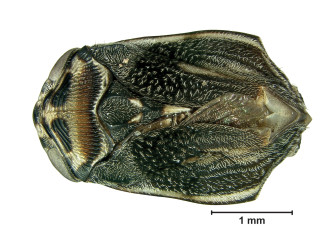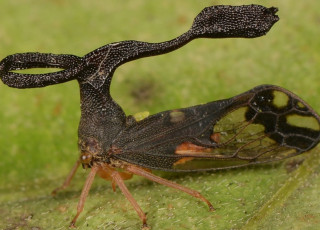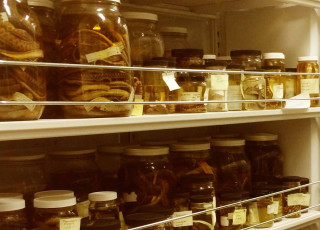Executive Director Jason Cryan Helps Discover New Amazonian Species
Spittlebug experts in the field: (left to right) Andressa Paladini, K.G. Andrew Hamilton, Dan Peck, Vinton Thompson, Jason Cryan, and Adam Bell. Photo credit: Jason Cryan.
By Jason Cryan
We know a lot about our planet and what lives on it. But, there’s still so much that we don’t know about life on Earth. There are so many discoveries waiting to be made. Each and every time a previously unknown living thing is newly discovered and described is an exciting event – the exploration and discovery of our world’s amazing biodiversity is a cause for celebration.
I’ve had the good fortune to have discovered many insect species during my career as a biodiversity scientist. My research focuses on a charismatic – and sometimes unbelievable – group of insects including planthoppers, tree- and leafhoppers, cicadas, and spittlebugs. These plant-sap eating bugs are famous in the entomological world for having crazy shapes, bright colors, and interesting behaviors. “Hoppers” are found all over the world (including Utah), but their richest diversity is found in the tropics – because of that, I’ve explored insect diversity in rainforests and jungles around the globe. For me, there’s no greater excitement than exploring remote tropical forests where few people have ever been and observing the fantastic biodiversity in those special places. Encountering a species that nobody has ever seen before is the icing on that cake--there’s something extraordinary about discovering and formally introducing a living thing that had gone undetected until now.
Specimens that field scientists collect often are ultimately deposited in museums, where they are available for other scientists to study. And although that may take years to happen, the importance of museum collections as repositories of natural diversity cannot be overstated.

I was recently part of a research team that brought together several of the world’s experts on a group of hoppers called spittlebugs. These bugs are well known for their larval behavior of creating and living in frothy, semi-liquid blobs (that look just like human spit) on their host plants; as adults, they emerge from their slimy home and are free-living as they search for mates. This insect group includes several significant pests of world agricultural crops such as rice, sugarcane, and wheat, as well as improved pasture grasses for livestock grazing.
My research team just published a scientific article that includes the formal scientific description of a “new” species of spittlebug from the Amazonian rainforests of Ecuador and Brazil. Nothing of this diminutive bug’s biology is known--what plant it eats, how extensive its range is, or what behaviors it displays. However, with distinctly unusual ridges on its back and curiously hairy wings, its anatomy is strikingly different from the other species that are closely related to it. In fact, because of these significant physical differences, we decided that this new species deserves its own genus, and so we established a whole new category for it: the new genus Paraclastoptera.
The nine known specimens of this attractive little spittlebug were collected by Dr. Terry Erwin and his research team between 1979-1996, and remained unnoticed in biological collections since. This highlights the importance of museum collections not only as snapshots of the world’s biodiversity through time, but also as ‘treasure chests’ of life – both known and unknown. Dr. Erwin, who sadly died in 2020, was an entomologist with the Smithsonian Institution’s National Museum of Natural History, and had rocked the scientific world with his estimates of global biodiversity calculated from long-term insect collection research in Amazonian rainforest canopies. To honor Dr. Erwin for collecting these specimens and for his contributions to biodiversity research, we named the new species Paraclastoptera erwini.
Jason Cryan, Ph.D., is a biodiversity scientist and the executive director of the Natural History Museum of Utah. NHMU is part of the University of Utah in Salt Lake City. Our mission is to illuminate the natural world and the place of humans within it. In addition to housing outstanding exhibits for the public, NHMU is a research museum. Learn more.




